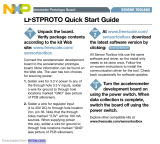
AN1986
Sensors
4 Freescale Semiconductor
able to determine the harmonics of the motor and monitor
when the values have changed, predicting a problem with the
machinery before a failure occurs. The Music Pitch Analysis
Demo uses an accelerometer to detect the harmonics from a
vibration. This can be quickly demonstrated using tuning forks
with the TRIAX board. For example, striking an “A” tuning fork
and placing it next to the TRIAX board, the highest amplitude
frequency recognized by the accelerometer would be 440 Hz
and the check box corresponding to an “A” would be selected.
See Figure 8.
Figure 8. Music Pitch Analysis Demo
Accelerometers can also be used to detect the rotational
vibration (RV) of hard disk drives (HDDs). When the RV
characteristics of an operational HDD becomes too large or
contains certain spectral content, the drive’s performance is
often compromised. Poor seek times, read/write errors, and
lost data can be the result of excessive RV. The
accelerometer detects the RV and enables the HDD to adjust
the drive for better operation.
Shock Measurement
Shock Applications range from Black Boxes and Event
Data Recorders, Hard Disk Drive Protection, and Shipping &
Handling Monitors to record shock levels experienced during
transportation of fragile products.
The Shock Detection Module provides a simple
demonstration of using the accelerometer to not only detect
shock, but also to detect which axis the shock occurred. This
is a stand-alone module. Therefore, once the Shock Detection
Module is selected, the serial cable can be disconnected for
the demonstration. The TRIAX board beeps once when the
impact occurs in the X-axis, twice when it occurs in the Y-axis
and three times when the impact occurs in the Z-axis.
This demonstration can be further enhanced by adding
software to sample the signal for shock recognition features
that would determine different actions for different types of
shock. The accelerometers available on the TRIAX board are
±1.5g, therefore the shock conditions are anything above 1g.
For many applications, a higher g-range is necessary.
Freescale offers accelerometers from ±1.5g all the way up to
±250g. For applications requiring a higher g range, there are
devices available.
Circuit Description
The TRIAX board is used to demonstrate many different
applications; therefore it was not optimally designed for one
specific application. The basic components are three low g
accelerometers, a microcontroller, serial communication
circuitry, EEPROM for data collection, and a piezohorn. This
TRIAX board displays the three-axis solution with three
accelerometers in the 16-pin SOIC. The microcontroller
selected was the MC68908KX8. It was selected because it
has an SCI required for the serial communication, four 8-bit
ADC channels, three of which are required for the three
accelerometer voltage outputs, and 8 Kb of on-chip, in-circuit
programmable FLASH memory that is used for calibration
data and remembering which software module was last run
using the PC.
Figure 9. MC68HC908KX8 PDIP and SOIC
Pin Assignments
Calibration
The zero g offset for the MMA1260D and the MMA2260D
accelerometers are specified with a typical value of 2.5 V ±.
Follow these steps to determine the calibration values.
Write down the A/D values for the X, Y, and Z outputs at 0g
and 1g:
1. Start the RAW data software module.
2. Enter the A/D values for X, Y, and Z when experiencing
0g and 1g of static acceleration. Refer to Table 1 to see
how to position the TRIAX boards to achieve the correct
values.
3. Write the value in a similar table as show in Figure 10.
4. Close the RAW data module.
5. Start the CALIBRATE software module.
6. Fill in the A/D values that were determined. See
Figure 11 for typical values.
7. Press the Calibration button.
8. Close the CALIBRATE software module.
Figure 10. Calibration Data Table
PTB7/(OSC2)/RST
V
DD
PTA4/KBD4
PTA3/KBD3/TCH1
PTA2/KBD2
/TCH0
PTB4/RXD
PTB6/(OSC1
PTB5/TXD
PTB3/AD3
VSS
PTA1/KBD1
PTA0/KBD0
IRQ1
PTB0/AD0
PTB2/AD2
PTB1/AD1
8
2
3
4
5
7
6
9
16
15
14
13
12
10
11
1
0g
1g
X AXIS Y AXIS Z AXIS










